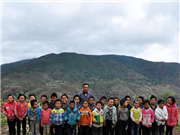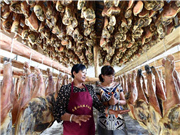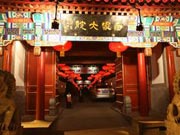

5) Progress was made in the reform of State-Owned Enterprises (SOEs).
Guidelines for reforming the remuneration system for executives in central government enterprises were introduced. Pilot reforms were launched to reorganize central government enterprises as state-owned asset investment companies, develop a mixed-ownership economy, and standardize the boards of directors in central government enterprises. Further progress was made in the merging and reorganization of SOEs.
6) Social reforms proceeded in an orderly fashion.
Guidelines for comprehensive reform of the system for the use of official vehicles were formulated, and were implemented first in the bodies of the CPC Central Committee and central government. Plans for a system of public credit records were promulgated and implemented, and mechanisms to enable different departments to share credit information and take joint punitive actions against those who act in bad faith were improved. Significant progress was made in the establishment of a unified registration system for immovable property. The reform of the school examination and enrollment systems was vigorously promoted. The plan for old-age insurance reform in Party and government bodies and public institutions was promulgated as expected. The majority of China’s provincial-level administrative areas have established systems enabling residents to settle medical bills incurred in any locality within that jurisdiction via their medical insurance accounts. Trials for the comprehensive reform of county-level public hospitals have been extended to over 50% of counties or county-level cities throughout the country.
7) A new phase of reform and opening up has been initiated.
The strategy of developing the Silk Road Economic Belt and 21st Century Maritime Silk Road entered the implementation phase, the construction of infrastructure was strengthened with a view to achieving better connectivity with neighboring countries, and the opening up of markets in border areas and inland areas was expanded. The operation of the China (Shanghai) Pilot Free Trade Zone yielded transferable experience that can be replicated in other reform projects. The utilization of foreign capital was enhanced in terms of both quality and structure. Non-financial foreign direct investment actually utilized in 2014 totaled US$119.6 billion, up 1.7% year on year. The proportion of foreign investment utilized in the service sector reached 55.4% of the total. Efforts were redoubled to promote international cooperation on production capacity and encourage Chinese equipment to “go global,” and good progress was made in initiatives to promote Chinese rail transit equipment, electricity generation, telecommunications, and energy on the international market. China’s non-financial outward direct investment reached US$102.9 billion for the year, up 14.1%. A pattern of synchronous growth in inward and outward investment began to take shape.
3. We accelerated industrial structural adjustment and vigorously promoted economic transformation and upgrading.
Through exerting market forces and enhancing policy guidance, we sped up the transformation of the economic growth model and gave new impetus to the improvement and upgrading of the industrial structure.
1) New breakthroughs were made in innovation.
Spending on R&D as a percentage of GDP reached 2.09% in 2014, with corporate R&D spending accounting for over 76% of the total. Cutting-edge innovations such as the Tianhe-2 supercomputer, super-hybrid rice, the Chang’e lunar lander, satellite applications, and the deep-sea manned submersible Jiaolong captured global attention. Breakthroughs were made in a number of key and core technologies and industrial applications, covering the fields of biology, intelligent manufacturing equipment, ocean engineering equipment, regional airliners, mobile Internet, and broadband network equipment. There was rapid development in strategic emerging industries, such as cloud computing, the Internet of Things, and big data. Micro-innovation, crowd innovation, and other innovative and entrepreneurial models showed robust growth. The value-added of the high-tech manufacturing sector rose by 12.3%, four percentage points higher than that of industrial enterprises with annual revenue of 20 million yuan or more from their main business operations.
2) Good headway was made in transforming and upgrading traditional industries.
The technological upgrading of enterprises in traditional industries was carried out vigorously. Initiatives to adjust the distribution of key industries and relocate industries gathered pace. Steady progress was made in the elimination of excess production capacity. Tasks set out at the beginning of last year to eliminate excess production capacity in 15 key industries were completed as planned, effectively curbing the blind expansion of production capacity. Important gains were made in turning the coal industry around.
 |  |
Day|Week

 Tsinghua junior makes over 10,000 yuan a day by selling alumnae's used quilts
Tsinghua junior makes over 10,000 yuan a day by selling alumnae's used quilts Graduation photos of students from Zhongnan University
Graduation photos of students from Zhongnan University A school with only one teacher in deep mountains
A school with only one teacher in deep mountains Glimpse of cultural heritage "Xilankapu"
Glimpse of cultural heritage "Xilankapu" Homemade cured hams in SW China
Homemade cured hams in SW China Breathtaking buildings of W. Sichuan Plateau
Breathtaking buildings of W. Sichuan Plateau Graduation photos of "legal beauties"
Graduation photos of "legal beauties" Top 10 most expensive restaurants in Beijing in 2015
Top 10 most expensive restaurants in Beijing in 2015